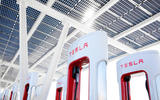UK Tesla owners are bracing for impact: is 2022 the year in which the velvet rope that separates its Supercharger network finally removed?
The network is arguably the jewel in the crown of Tesla ownership, the element that has taken much of the stress out of early EV adoption, but CEO Elon Musk has made clear that he wants to throw it open to non-Tesla EV drivers.











Join the debate
Add your comment
I’m not a Tesla owner but I do run an EV and are hugely envious of their Supercharger network. Unlike other manufacturers Tesla out the horse before the cart and have scored a real strategic advantage by having a reliable international charging network that is seemlesely integrated with their models SatNav and software systems. Far from being altruistic I think Tesla are only offering up their charging network to appease the competition authorities and regulators. There is however a major difficulty for most other EVs who try to hook up and that is that the Tesla cables are very short and only designed to extend to the charging port at the rear of the car - Tesla ports are on the rear nearside corner - so will not extend to the port on most EVs. You can also be sure Tesla will (rightly) charge a premium rate for non Tesla vehicles. The answer to the present woeful lack of reliable working chargers at motorway service areas and on major trunk roads is for the Ionity to consortium (VW group, BMW, Mercedes Benz, Ford and Hyundai) to invest much more in rolling out big charging hubs to mirror what Tesla have done. They also need to integrate these within their SatNav systems so that suggested charging locations are planned for journeys beyond the vehicle’s range. I am not a great fan of Tesla cars (dubious buIld quality, poor choice of options, over minimalist interior) but there is absolutely no doubt that Tesla have removed all the anxiety of going Electric.
Right on most counts but try and book a test drive in a model 3 for build quality. I think you would be surprised at how good it actually is. I had german company cars for years particularly BMWs and they never failed to dissapoint over the long term.
Tesla have definitely got the supercharger network absolutely spot on for ease of use and modest costs. I would want other cars to be charged a premium for using the network.
Not sure letting the muggles charge at teslas supercharger network is a good idea unless the muggles are charged more than I get charged at supercharger locations which is also a USB that us Tesla owners enjoy. Everyone knows that the other charging competitors are very unreliable and very expensive to use so Tesla should also charge non Teslas appropriately
As a Tesla driver I say bring it on. It'll be good for EV take up, which is the main thing for me, but may reduce some of the anti-Tesla sentiment. It's getting so bad it feels like I'm driving an Audi some days.
Agreed bol. And certian people will still be ranting about Tesla fanboys after topping up at a Tesla charger, hyprocrites.
Ha Ha - Brillant.
Its especially hard to acccept the EV revolution if invested in ICE for 100 years, its glory of noise, power, complex ingenuity, gear changing & mastering its power peaks.
But please, Autocar keep the playing field level, inspite of advertising, foreign jollies, big oil and 2 faced FUD from some foot dragging auto makers.